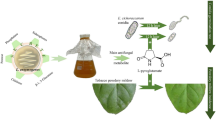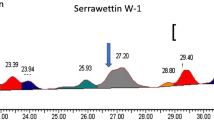Abstract
Pseudomonas fluorescens strain 2-79 (NRRL B-15132) is a classic biological control agent known to produce phenazine-1-carboxylic acid (PCA) as its primary means of suppressing take-all disease of wheat. In addition to PCA, an unknown metabolite was discovered in a liquid culture used to produce the biocontrol agent. The objective of the current study was to isolate, identify, and evaluate the accumulation of this compound in production cultures. Upon centrifugal fractionation of a production culture, thin-layer chromatography (TLC) analyses of extracts of the cells and cell-free supernatant indicated the compound to be primarily in the supernatant. Purified compound was obtained by extraction of culture supernatant, followed by flash chromatography of the extract and preparative TLC. The 1H and 13C nuclear magnetic resonance and electron impact mass spectra indicated the compound to be 2-acetamidophenol (AAP). Measured by reversed-phase HPLC, the accumulations of AAP and PCA in cultures of strain 2-79 reached 0.05 g/l and 1 g/l, respectively. The accumulations of AAP and PCA in liquid cultures were linearly correlated (P < 0.001), as shown by studies of cultures stimulated to yield varying levels of PCA by controlling levels of oxygen transfer, pH, and growth medium composition. In this study, oxygen limitation, a defined amino-acid-free medium, and neutral pH stimulated maximal production of both AAP and PCA. Furthermore, a transposon mutant of 2-79 [2A40 2-79 (phz–)] unable to produce PCA did not accumulate AAP. These findings indicate that AAP and PCA are likely to share a common segment of biosynthetic pathway. This is the first report of AAP production by a strain of P. fluorescens. Possible routes of AAP production are discussed relative to current knowledge of the phenazine biosynthetic pathway of strain 2-79. The pertinence of AAP to the design of commercial seed inoculants of phenazine-producing bacteria for controlling wheat take-all is also considered.
Similar content being viewed by others
Author information
Authors and Affiliations
Additional information
Received: 2 November 1999 / Received revision: 3 April 2000 / Accepted: 14 April 2000
Rights and permissions
About this article
Cite this article
Slininger, P., Burkhead, K., Schisler, D. et al. Isolation, identification, and accumulation of 2-acetamidophenol in liquid cultures of the wheat take-all biocontrol agent Pseudomonas fluorescens 2-79. Appl Microbiol Biotechnol 54, 376–381 (2000). https://doi.org/10.1007/s002530000409
Issue Date:
DOI: https://doi.org/10.1007/s002530000409




